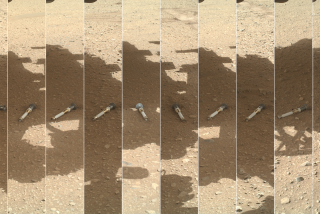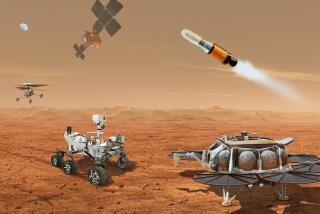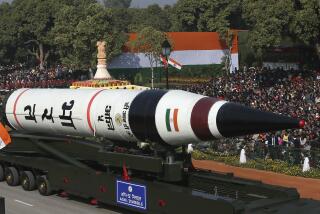India set to launch Mars mission, provoking criticism over cost
NEW DELHI — India is set to launch a space mission to Mars on Tuesday that, if successful, would beat China to the punch, although some wonder whether the undertaking is the best use of money when many Indians lack food, clean water or basic sanitation facilities.
The 3,000-pound Mars Orbiter Mission probe, or Mangalyaan, is set to lift off at 2:38 p.m. local time (1:18 a.m. PST) aboard a 350-ton, four-stage Polar Satellite Launch Vehicle, the first step in its 300-day trip to the red planet. The cost of the mission is approximately $73 million.
The launch -- which follows India’s successful 2008 moon orbiter mission, the Chandrayaan-1 -- is scheduled to take place at the Satish Dhawan Space Center in Sriharikota on the Bay of Bengal some 60 miles north of Chennai in southeastern India.
If successful, India would be the sixth nation to launch a Mars mission, after the U.S., Russia, China, Japan and the European Union. But only three of those reached the planet’s orbit — China and Japan failed — underscoring the long odds.
If all goes as planned, the orbiter will take about 47 minutes to reach Earth orbit, where it will stay until Dec. 1 before starting the 240-million-mile voyage to Mars. The vessel is slated to reach the red planet’s orbit around Sept. 24, 2014.
For added insurance, the chairman of the Indian Space Research Organization sought the blessings of Lord Vishnu, the Hindu god of preservation, placing a scale model of the launch vehicle, the PSLV-C25, at the idol’s feet Monday at the lavish Tirumala shrine 80 miles from Chennai.
“These temple visits helped destress the mind and offer clarity,” the Hindustan Times newspaper explained.
Civic groups have criticized the cost, in a country where hundreds of millions of people still lack toilets. “I think it’s so strongly symbolic of an extremely unequal society,” said Harsh Mander, director of New Delhi’s Center for Equity Studies, a think tank, and a former advisor to the prime minister on social issues. “We continue to have something like 230 million people who sleep hungry every night, and millions die because they can’t afford healthcare. Yet these are not issues that cause outrage.”
But scientists defended the mission, arguing that it costs only a little more than 6 cents per capita in a nation with a population of 1.2 billion, roughly the same as an aircraft, and brings pride to the country.
“There are social benefits,” including weather satellites that save lives, said Ajey Lele, a research fellow with the Institute for Defense Studies and Analyses, a think tank. Of the opposition to the mission, Lele said, “I think all these arguments are mere rhetoric.”
Indian scientists said the mission has two objectives. It will test and showcase Indian technology as India attempts its first foray beyond Earth’s orbit through some of space’s harshest conditions. And once in Mars’ orbit, it will attempt scientific experiments related to climate, geology and evidence of past water, pointing to possible signs of early life.
India also hopes a successful mission will promote the capability and affordability of its commercial satellite-launching service. So far, it has launched 35 satellites for other countries, Lele said, and is eager to do more. This mission’s $73-million price tag compares with $2.5 billion for NASA’s Mars Curiosity mission and $1.5 billion for a NASA rover planned for 2020. “India’s making a statement, that we can do it,” Lele added.
Better missile and satellite technology also benefits India’s communication and defense industries, analysts argued, as China and India expand their influence in Asia. And, if successful, the mission will give India bragging rights over China, making it the first Asian nation to reach Mars orbit.
In 1999, Japan’s Nozomi Mars spacecraft failed. And in 2011, China’s first Mars satellite, the Yinghuo-1, was destroyed when the Russian carrier spacecraft it was on was unable to leave Earth’s orbit. India announced its program a few months after China’s bid failed, raising talk of a space race in Asia.
But India faces long odds. The failure rate for Mars missions among various space powers is higher than 50%, with some missions missing the planet completely or crashing into it.
The U.S. is the only nation that’s sent robotic explorers to Mars, the most recent being Curiosity, which touched down in August 2012. NASA is set to launch on Nov. 18 another Mars mission called Maven, for Mars Atmosphere and Volatile Evolution, designed to explore climate data that may help scientists better understand climate change on Earth. Indian officials said NASA will help India track its own vessel during its nearly yearlong trip.
ALSO:
Egypt: Morsi trial delayed after chaotic start
Toronto mayor admits getting ‘hammered,’ deflects drug reports
Hundreds of masterpieces, possibly looted by Nazis, found in Germany
Tanvi Sharma in the New Delhi bureau contributed to this report.
More to Read
Sign up for Essential California
The most important California stories and recommendations in your inbox every morning.
You may occasionally receive promotional content from the Los Angeles Times.










